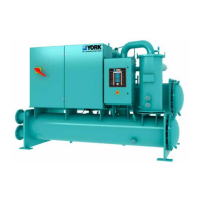JOHNSON CONTROLS
47
SECTION 3 - HANDLING, STORAGE, INSTALLATION AND REASSEMBLY
FORM 201.30-ICOM1 (519)
ISSUE DATE: 05/22/2019
3
PROCEDURES
Cleaning
Clean the parts visually contaminated with oil, grease,
or dirt with a generous spray of cleaner 7070. Wipe
them dry with a clean towel while they are still wet.
Priming
Use the following steps to prime the joints.
1. If required, use N7649 general purpose primer.
Primers are generally required when assembling
dissimilar metals. In this case, apply primer to the
inactive surface.
a. Active surfaces (Primer optional): Brass,
copper, bronze, iron, soft steel, and nickel.
b. Inactive surfaces (Primer required): Alumi-
num, stainless steel, magnesium, zinc, black
oxide, cadmium, titanium, and others.
2. After application, allow the primer to visibly dry
(3-5 minutes) before assembling the joint.
3. Primer can also be used at the discretion of the
facility to accelerate curing of sealer on any sur-
face, which is often helpful in low temperature
conditions.
Primer will accelerate the cure time for
the sealant. Complete joint assembly
quickly, if primer is used.
GASKET JOINTS
Assembling Gasket Joints
Use the following instructions to assemble the gasket
joints.
1. Clean and lubricate all screw threads, unless
plated, before tightening. All threaded fasteners
(bolts, nuts or cap screws) shall be tightened per
sequence shown in Figure 26 on page 47 for
an eight fastener joint. Use a similar sequence for
joints with a greater number of bolts.
2. Apply the torque evenly in gradual increments
until the desired torque limit is reached, to make
sure the proper amount is applied to the gasket
loading.
3. Relaxation of the gasket after tightening, in a
properly torqued gasketed joint, is expected. Prior
to nal testing and start-up, retighten the bolts for
refrigerant joints to eliminate gasket relaxation.
2
7
4
6
8
3
FIGURE 26 - TORQUE PATTERN
LD16438
TABLE 11 - ANSI 150 LB FLANGE TORQUE SPECIFICATIONS
NOM. SIZE (IN) BOLT SIZE (IN) QUANTITY
APPLIED TORQUE IN FT-LB APPLIED TORQUE IN NM
MINIMUM MAXIMUM MINIMUM MAXIMUM
1-1/4 in 1/2-13 4 24 108 33 146
1-1/2 in 1/2-13 4 32 120 43 163
5 in 3/4-10 8 110 415 149 563
TABLE 12 - ANSI 300 LB FLANGE TORQUE SPECIFICATIONS
NOM. SIZE (IN) BOLT SIZE (IN) QUANTITY
APPLIED TORQUE IN FT-LB APPLIED TORQUE IN NM
MINIMUM MAXIMUM MINIMUM MAXIMUM
3-1/2 3/4-10 8 97 329 132 446
4 3/4-10 8 122 417 165 565
NOTE: Torque > 1000 use value plus 10% for range.

